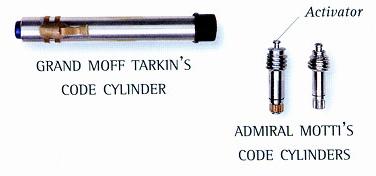Palpatine's Galactic Empire used specific code cylinders to provide its officers with security clearance codes. In combination with the rank plaques, these code cylinders were also used to denote rank within the hierarchy. Imperial code cylinders were introduced since the early days of the new regime, and they remained in use among the Imperial splinter factions after the Empire collapsed at the Battle of Endor.
Imperial code cylinders were among the most common access tools employed by the Galactic Empire. Standing regulations demanded that every Imperial officer's code cylinders were in view at all time, and they were kept in narrow pockets on either side of the upper chest. However, only high ranking officers displayed them on their jacket; Imperial engineers and technicians wore them in special pockets around their neck or on their belt.
Imperial installations were divided into a variety of sectors, each separated from others by security checkpoints. At major checkpoints, officers who wished to access the next secured area had to prove their identity and rank by inserting individualized cylinders into a scomp link. The scomp link interfaced with a centralized computer, which determined whether the officer had the proper clearance before denying or approving their access request. Due to their use, Imperial code cylinders enforced discipline among the lower ranks and contributed to the insignia of officers and subofficers by indicating seniority.
All officers of the Navy and Army were issued with at least one cylinder, which they were ordered to display at all time. A second device was sometimes issued when an officer's duty spanned a number of unrelated sectors. Admirals of the Fleet were usually issued with three code cylinders, which enabled them to access the intelligence databanks carried by capital ships. Because each cylinder permitted access to only specific sectors, high-ranking officers carried up to four of them. Aboard the first Death Star, Grand Moff Wilhuff Tarkin possessed four cylinders, which allowed him to travel freely throughout the moon-sized battle station. In contrast, General Cassio Tagge and Admiral Conan Antonio Motti carried only three code cylinders.
While some officers considered the cylinders a mere mark of their status, the devices were also programmed to give the Empire a detailed knowledge of its servicemen's actions. The Imperial computer network kept detailed records of every cylinder's activity, including every time a sensitive file was accessed or a high-security area was entered. Such logs were monitored by agents of the Imperial Security Bureau who scanned the records in search of suspicious behavior—including over-frequent access to a secured file or area.

Imperial code cylinders came in a variety of shapes.
The Imperial code cylinders came in at least three different shapes, as the ones worn by Grand Moff Tarkin, Admiral Motti and the Stormtrooper officers were significantly distinct. The most common type of cylinders looked like thin pens with a small pocket clip and a blue tip containing the series code. Those worn by the Stormtrooper corps were shorter, with a different pocket clip. Admiral Motti's cylinder were thicker and featured a spiral drill bulb at the top, which was in fact the computer link itself.
The Galactic Empire used code cylinders from its early days on. When the Galactic Emperor gathered most influential officers in order to introduce them to his new second-in-command, Darth Vader, all of them already wore at least one code cylinder.
After the Empire collapsed at the Battle of Endor, code cylinders remained in use in surviving Imperial outposts. The New Republic, the democratic government established by the Rebel Alliance, also started to use similar coded cards or pass-keys to verify an individual's identity.
The code cylinders used by the Galactic Empire first appeared in Star Wars: Episode IV A New Hope, the first installment of the Star Wars original trilogy. In the movies, some of the Imperial code cylinders were small pen-like radiation dosimeters. However, the Stormtrooper cylinders that were shown in Star Wars: The Visual Dictionary were in fact chalk holders that were provided to David West Reynolds by Mathew Clayson.
- Death Star Technical Companion
- The Movie Trilogy Sourcebook
- Death Star Technical Companion, Second Edition
- Shadows of the Empire Planets Guide
- Star Wars: Behind the Magic
- Star Wars: The Visual Dictionary
- The Official Star Wars Fact File4
- Star Wars Roleplaying Game Revised Core Rulebook
- Coruscant and the Core Worlds
- The Official Star Wars Fact File121
- Star Wars: The Complete Visual Dictionary
- "Set Piece: Death Star Conference Room" — Star Wars Insider 96
- Threats of the Galaxy
- The Complete Star Wars Encyclopedia